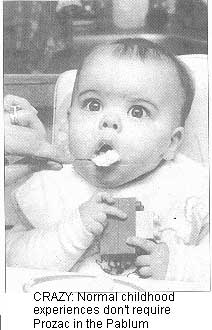

Losing our sanity, from cradle to couch:
Early-intervention psychiatry
for young children may do more harm than good
Early-intervention psychiatry
for young children may do more harm than good
May
is Mental Health Month across North America and with it comes the usual
warnings of a plethora of psychiatric maladies waiting to beset us. But
this year, children—even infants who can’t even hold their
heads up—are being targeted.
As a society, we’re already sensitized to Attention Deficit Hyperactive Disorder in school-age children, a childhood obesity epidemic, adolescent eating disorders, suicidal teens, and traumatized casualties of bullying.
We’ve come to accept the statistic that mental illness strikes one in eight adolescents. But it seems this is only the tip of a mental illness iceberg. Our wee ones are apparently suffering from disorders as adult-sounding as clinical depression and post traumatic stress disorder. Alarm bells are being sounded. These children need immediate treatment, the experts say. And, if we don’t give it to them, there will be “serious consequence down the line”—more serious episodes, emotional pain, chronic disabilities and an increased risk of suicide. Up to now, the problem confronting clinicians has been that of identifying these disorders in those too young to talk or who, as the American Psychiatric Association puts it, “do not yet possess the emotional development or the self-awareness to define and communicate their depression to adults.”
But experts now believe that they have solved the problem. Don’t worry about getting the child to talk; rely solely on clinical “instinct” (which seems strangely close to mind-reading) and some symptom checklists created for the occasion.
As they watch children at play, clinicians look for something called anhedonia, a psychobabble word not to be found in dictionaries, which means the lack of ability to experience pleasure. According to Joan Luby, an assistant professor of child psychiatry at the Washington School of Medicine in St. Louis, Missouri, this is one of the clear indicators of depression in preschoolers, If a child is not, in the psychiatrist’s mind, experiencing pleasure, he or she is depressed. Anhedonia is “unique to those who were depressed” they say, an obvious case of circular thinking since it was also the way they were diagnosed as depressed.
Others, such as Michael S. Scheeringa, assistant professor in the Department of Psychiatry and Neurology at Tulane Medical School in New Orleans, have lowered the bar on another disorder once reserved for adults. He believes that children as young as infants can suffer not only from depression but even from post-traumatic stress disorder. Alicia Lieberman, director of the Child Trauma Research Project at San Francisco General Hospital, agrees, citing PTSD as a cause of something she calls “post-traumatic play.”
Mental health workers have fallen victim to the notion that they have the uncanny ability to detect mental illness in infants just by looking at them and imagining what they are thinking. Depressed babies, according to Alice Sterling Honig, professor emeritus of child development at Syracuse University, “look listless, with dull eyes, as if they gave up looking for their special person.” Babies as young as four months, she believes, show “signs of stress seen in much older people.”
The infancy advocacy group Zero to Three offers a handbook for psychiatrists and psychologists to strengthen their position and support their practice. With the awkward title: “Diagnostic Classification of Mental Health and Development Disorders of Infancy and Early Childhood,” it lists all possible (and imaginable) diagnoses and their symptoms. Modeled on the Diagnostic and Statistical Manual of Mental Disorders, Fourth Edition, it treats infants and children as miniature adults prone to the same types of disorders identifiable in their moms and dads.
Are any of these opinions and assessments reliable? Or are they just another sign of a mental-health industry that wants to expand its influence and prosperity?
With each month and year that passes, the confidence of child experts in their ability to diagnose grows as does their list of publications which fosters the impression that they really do know what they’re doing. Yet it all hangs on something akin to mind reading, guessing and proselytizing.
Who knows whether a “listless look” indicates depressive thinking or just a full stomach or a gas pain? Or whether anhedonia is something that toddlers feel or adults imagine? Or whether frequent night wakings in infants are a sleep disorder or just an exhausting parental nuisance?
Perhaps the answer can be found in the nature of the treatment, one that relies heavily on medications. A recent survey of pediatricians, by Carol Rosen of Case Western State University, finds that 75 per cent of them prescribe sleeping medication for young children although such practice is not approved. And, although drugs such as Prozac have not been approved for infants and young children—which means there is no evidence that they are safe in the long term—tiny dosages mixed with pabulum are being readily prescribed. Possibly, all of this is just a marketing tool to create infant mental illness as a niche, a new area in which to claim expertise. Or maybe there is a motive less sinister but all the more disturbing because of its naive benevolence. Accustomed as they are to seeing each and every aspect of life as a “mental health issue,” these practitioners may truly believe that helping infants handle the challenges of life “will pay off down the line.”
My concern is that they’re teaching all of us, parents and children alike, that psychological experts are needed from birth to death, that drugs are a way of handling life’s ups and downs, and that growing up in this world involves learning to see through psychologically tainted glasses.
As a society, we’re already sensitized to Attention Deficit Hyperactive Disorder in school-age children, a childhood obesity epidemic, adolescent eating disorders, suicidal teens, and traumatized casualties of bullying.

We’ve come to accept the statistic that mental illness strikes one in eight adolescents. But it seems this is only the tip of a mental illness iceberg. Our wee ones are apparently suffering from disorders as adult-sounding as clinical depression and post traumatic stress disorder. Alarm bells are being sounded. These children need immediate treatment, the experts say. And, if we don’t give it to them, there will be “serious consequence down the line”—more serious episodes, emotional pain, chronic disabilities and an increased risk of suicide. Up to now, the problem confronting clinicians has been that of identifying these disorders in those too young to talk or who, as the American Psychiatric Association puts it, “do not yet possess the emotional development or the self-awareness to define and communicate their depression to adults.”
But experts now believe that they have solved the problem. Don’t worry about getting the child to talk; rely solely on clinical “instinct” (which seems strangely close to mind-reading) and some symptom checklists created for the occasion.
As they watch children at play, clinicians look for something called anhedonia, a psychobabble word not to be found in dictionaries, which means the lack of ability to experience pleasure. According to Joan Luby, an assistant professor of child psychiatry at the Washington School of Medicine in St. Louis, Missouri, this is one of the clear indicators of depression in preschoolers, If a child is not, in the psychiatrist’s mind, experiencing pleasure, he or she is depressed. Anhedonia is “unique to those who were depressed” they say, an obvious case of circular thinking since it was also the way they were diagnosed as depressed.
Others, such as Michael S. Scheeringa, assistant professor in the Department of Psychiatry and Neurology at Tulane Medical School in New Orleans, have lowered the bar on another disorder once reserved for adults. He believes that children as young as infants can suffer not only from depression but even from post-traumatic stress disorder. Alicia Lieberman, director of the Child Trauma Research Project at San Francisco General Hospital, agrees, citing PTSD as a cause of something she calls “post-traumatic play.”
Mental health workers have fallen victim to the notion that they have the uncanny ability to detect mental illness in infants just by looking at them and imagining what they are thinking. Depressed babies, according to Alice Sterling Honig, professor emeritus of child development at Syracuse University, “look listless, with dull eyes, as if they gave up looking for their special person.” Babies as young as four months, she believes, show “signs of stress seen in much older people.”
The infancy advocacy group Zero to Three offers a handbook for psychiatrists and psychologists to strengthen their position and support their practice. With the awkward title: “Diagnostic Classification of Mental Health and Development Disorders of Infancy and Early Childhood,” it lists all possible (and imaginable) diagnoses and their symptoms. Modeled on the Diagnostic and Statistical Manual of Mental Disorders, Fourth Edition, it treats infants and children as miniature adults prone to the same types of disorders identifiable in their moms and dads.
Are any of these opinions and assessments reliable? Or are they just another sign of a mental-health industry that wants to expand its influence and prosperity?
With each month and year that passes, the confidence of child experts in their ability to diagnose grows as does their list of publications which fosters the impression that they really do know what they’re doing. Yet it all hangs on something akin to mind reading, guessing and proselytizing.
Who knows whether a “listless look” indicates depressive thinking or just a full stomach or a gas pain? Or whether anhedonia is something that toddlers feel or adults imagine? Or whether frequent night wakings in infants are a sleep disorder or just an exhausting parental nuisance?
Perhaps the answer can be found in the nature of the treatment, one that relies heavily on medications. A recent survey of pediatricians, by Carol Rosen of Case Western State University, finds that 75 per cent of them prescribe sleeping medication for young children although such practice is not approved. And, although drugs such as Prozac have not been approved for infants and young children—which means there is no evidence that they are safe in the long term—tiny dosages mixed with pabulum are being readily prescribed. Possibly, all of this is just a marketing tool to create infant mental illness as a niche, a new area in which to claim expertise. Or maybe there is a motive less sinister but all the more disturbing because of its naive benevolence. Accustomed as they are to seeing each and every aspect of life as a “mental health issue,” these practitioners may truly believe that helping infants handle the challenges of life “will pay off down the line.”
My concern is that they’re teaching all of us, parents and children alike, that psychological experts are needed from birth to death, that drugs are a way of handling life’s ups and downs, and that growing up in this world involves learning to see through psychologically tainted glasses.
May 24, 2003 Pg. B7
tanadineen.com
@ Dr.Tana
Dineen
1998-2007
by
Dr. Tana Dineen, special columnist,